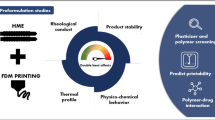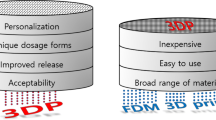Abstract
With the advancements in cutting-edge technologies and rapid development of medical sciences, patient-focused drug development (PFDD) through additive manufacturing (AM) processes is gathering more interest in the pharmaceutical area than ever. Hence, there is an urgent need for researchers to comprehensively understand the influence of three-dimensional design on the development of novel drug delivery systems (DDSs). For this research, fused deposition modeling (FDM) 3D printing was investigated, and phenytoin (PHT) was selected as the model drug. The primary purpose of the current investigation was to understand the influence of AM process on the pharmaceutical products’ quality. A series of comparative studies, including morphology, solid-state analysis, and in vitro drug release studies between additive manufactured filaments (printlets) and extruded filaments, were conducted. The FDM-based AM showed adequate reproducibility by manufacturing printlets with consistent qualities; however, the model slicing orientation significantly affected the print qualities. The texture analysis studies showed that the mechanical properties (breaking behavior) of additive manufactured printlets were varied from the extruded filaments. Additionally, the higher printing temperature also influenced the solid state of the drug where the process assisted in PHT’s amorphization in the printed products, which further affected their mechanical properties and in vitro drug release performances. The current investigation illustrated that the AM process would change the printed objects’ macrostructure over the conventional products, and the printing temperature and slicing will significantly affect the printing process and product qualities.












Similar content being viewed by others
References
Zhang J, Vo AQ, Feng X, Bandari S, Repka MA. Pharmaceutical additive manufacturing: a novel tool for complex and personalized drug delivery systems [Internet]. AAPS Pharm Sci Tech. Springer New York LLC; 2018 [cited 2020 Dec 28]. p. 3388–402. Available from: https://link-springer-com.ezproxy.lib.utexas.edu/article/10.1208/s12249-018-1097-x
Jamróz W, Szafraniec J, Kurek M, Jachowicz R. 3D Printing in pharmaceutical and medical applications – recent achievements and challenges [Internet]. Pharm Res. Springer New York LLC; 2018 [cited 2021 Feb 5]. p. 1–22. Available from: https://doi.org/10.1007/s11095-018-2454-x
Thakkar R, Pillai AR, Zhang J, Zhang Y, Kulkarni V, Maniruzzaman M. Novel on-demand 3-dimensional (3-d) printed tablets using fill density as an effective release-controlling tool. Polymers (Basel). [Internet]. Multidisciplinary Digital Publishing Institute; 2020 [cited 2020 Aug 25];12:1872. Available from: https://www.mdpi.com/2073-4360/12/9/1872
Zhang J, Thakkar R, Zhang Y, Maniruzzaman M. Structure-function correlation and personalized 3D printed tablets using a quality by design (QbD) approach. Int J Pharm [Internet]. Elsevier B.V.; 2020 [cited 2020 Oct 9];590:378–5173. Available from: doi: https://doi.org/10.1016/j.ijpharm.2020.119945
BSI. Additive manufacturing — general principles — terminology (ISO/ASTM 52900:2015). BSI Stand. Publ. [Internet]. 2017 [cited 2021 Feb 5]; Available from: https://www.iso.org/standard/69669.html
Gottwald J. U.S. Patent US3596285A Liquid metal recorder. 1971. https://patents.google.com/patent/US3596285A/en. Accessed 15 May 2021.
Erickson DM, Chance D, Schmitt S, Mathisf J. An opinion survey of reported benefits from the use of stereolithographic models. J Oral Maxillofac Surg. 1999;57:1040–3.
ASTM F42.91. F2792-12a: standard terminology for additive manufacturing technologies [Internet]. ASTM Int. 2012 [cited 2018 Jan 6]. p. 1–3. Available from: http://web.mit.edu/2.810/www/files/readings/AdditiveManufacturingTerminology.pdf
Aprecia Pharmaceuticals. First FDA-approved medicine manufactured using 3D Printing Technology now available. 2016 [cited 2017 Dec 4];6–8. Available from: https://www.aprecia.com/pdf/ApreciaSPRITAMLaunchPressRelease__FINAL.PDF
Hsiao W-K, Lorber B, Reitsamer H, Khinast J. 3D printing of oral drugs: a new reality or hype? Expert Opin Drug Deliv [Internet]. Taylor and Francis Ltd; 2018 [cited 2020 Oct 9];15:1–4. Available from: https://www.tandfonline.com/doi/full/10.1080/17425247.2017.1371698
• Most used 3D printing technologies 2020 | Statista [Internet]. [cited 2021 Feb 5]. Available from: https://www.statista.com/statistics/560304/worldwide-survey-3d-printing-top-technologies/#statisticContainer
Roberts T, Varotsis AB, Bukholt N, Juárez E, Lobovsky M, Bruner J, et al. 3D printing trends 2020-Industry highlights and market trends [Internet]. www.3dhubs.com. Amsterdam; 2020. Available from: https://downloads.3dhubs.com/3D_printing_trends_report_2020.pdf
Melocchi A, Parietti F, Maroni A, Foppoli A, Gazzaniga A, Zema L. Hot-melt extruded filaments based on pharmaceutical grade polymers for 3D printing by fused deposition modeling. Int J Pharm. Elsevier. 2016;509:255–63.
Volpato N, Kretschek D, Foggiatto JA, Gomez da Silva Cruz CM. Experimental analysis of an extrusion system for additive manufacturing based on polymer pellets. Int J Adv Manuf Technol [Internet]. Springer-Verlag London Ltd; 2015 [cited 2021 Feb 6];81:1519–31. Available from: https://link.springer.com/article/10.1007/s00170-015-7300-2
Zhang J, Feng X, Patil H, Tiwari R V, Repka MA. Coupling 3D printing with hot-melt extrusion to produce controlled-release tablets. Int J Pharm [Internet]. 2017 [cited 2020 Sep 26];519:186–97. Available from: https://linkinghub.elsevier.com/retrieve/pii/S0378517316311929
Monzón MD, Ortega Z, Martínez A, Ortega F. Standardization in additive manufacturing: activities carried out by international organizations and projects. Int J Adv Manuf Technol. Springer-Verlag London Ltd. 2014:1111–21. https://doi.org/10.1007/s00170-014-6334-1
Goyanes A, Fina F, Martorana A, Sedough D, Gaisford S, Basit AW. Development of modified release 3D printed tablets (printlets) with pharmaceutical excipients using additive manufacturing. Int J Pharm. Elsevier B.V. 2017;527:21–30.
Yang E, Miao S, Zhong J, Zhang Z, Mills DK, Zhang LG. Bio-based polymers for 3D printing of bioscaffolds [Internet]. Polym Rev. Taylor and Francis Inc.; 2018 [cited 2021 Feb 18]. p. 668–87. Available from: /pmc/articles/PMC6430134/
Garlotta D. A literature review of poly(lactic acid). J Polym Environ [Internet]. Springer; 2001 [cited 2021 Feb 18];9:63–84. Available from: https://link.springer.com/article/10.1023/A:1020200822435
Zhang J, Xu P, Vo AQ, Bandari S, Yang F, Durig T, et al. Development and evaluation of pharmaceutical 3D printability for hot melt extruded cellulose-based filaments. J Drug Deliv Sci Technol [Internet]. Elsevier; 2019 [cited 2019 May 2];52:292–302. Available from: https://www.sciencedirect.com/science/article/pii/S177322471930351X?dgcid=author
Crowley MM, Zhang F, Repka MA, Thumma S, Upadhye SB, Kumar Battu S, et al. Pharmaceutical applications of hot-melt extrusion: part I. Drug Dev Ind Pharm. Taylor & Francis. 2007;33:909–26.
Stanković M, Frijlink HW, Hinrichs WLJ. Polymeric formulations for drug release prepared by hot melt extrusion: application and characterization. Drug Discov Today. Elsevier. 2015;20:812–23.
Tiwari R V, Patil H, Repka MA. Contribution of hot-melt extrusion technology to advance drug delivery in the 21st century. Expert Opin Drug Deliv [Internet]. 2016 [cited 2018 Jun 1];13:451–64. Available from: http://www.tandfonline.com/doi/full/10.1517/17425247.2016.1126246
Repka MA, Langley N, DiNunzio J. Melt extrusion. Mater Technol Drug Prod Des. Springer. 2013;4:5.
Goyanes A, Buanz ABM, Basit AW, Gaisford S. Fused-filament 3D printing (3DP) for fabrication of tablets. Int J Pharm [Internet]. Elsevier; 2014 [cited 2017 Nov 7];476:88–92. Available from: http://www.sciencedirect.com/science/article/pii/S0378517314006991?via%3Dihub
Goyanes A, Buanz ABM, Hatton GB, Gaisford S, Basit AW. 3D printing of modified-release aminosalicylate (4-ASA and 5-ASA) tablets. Eur J Pharm Biopharm [Internet]. Elsevier; 2015 [cited 2017 Nov 7];89:157–62. Available from: http://www.sciencedirect.com/science/article/pii/S0939641114003580?via%3Dihub
Yu LX, Amidon G, Khan MA, Hoag SW, Polli J, Raju GK, et al. Understanding pharmaceutical quality by design. AAPS J. Springer New York LLC. 2014:771–783. https://doi.org/10.1051/matecconf/201713702006
Buttini F, Rozou S, Rossi A, Zoumpliou V, Rekkas DM. The application of quality by design framework in the pharmaceutical development of dry powder inhalers [Internet]. Eur J Pharm Sci. Elsevier; 2018 [cited 2018 Apr 16]. p. 64–76. Available from: https://www-sciencedirect-com.umiss.idm.oclc.org/science/article/pii/S0928098717306188
Coats AW, Redfern JP. Thermogravimetric analysis. A review. Analyst [Internet]. The Royal Society of Chemistry; 1963 [cited 2018 Jun 24];88:906–24. Available from: http://xlink.rsc.org/?DOI=an9638800906
Zhang T, Jin J, Yang S, Hu D, Li G, Jiang J. Synthesis and characterization of fluorinated PBO with high thermal stability and low dielectric constant. J Macromol Sci Part B Phys [Internet]. Taylor & Francis Group ; 2009 [cited 2021 Feb 12];48:1114–24. Available from: https://www.tandfonline.com/doi/abs/10.1080/00222340903041244
Milde J, Morovič L, Blaha J. Influence of the layer thickness in the fused deposition modeling process on the dimensional and shape accuracy of the upper teeth model.MATEC Web of Conferences. 2017;137(02006):1–10. https://doi.org/10.1051/matecconf/201713702006
3D Printing Layer Height: How Much Does It Matter? | All3DP [Internet]. [cited 2021 Feb 18]. Available from: https://all3dp.com/2/3d-printer-layer-height-how-much-does-it-matter/
PubChem. PubChem compound summary for CID 1775, phenytoin [Internet]. 2004. Available from: https://pubchem.ncbi.nlm.nih.gov/compound/Phenytoin. Accessed 15 May 2021.
Zhang J, Thakkar R, Zhang Y, Maniruzzaman M. Microwave induced dielectric heating for the on-demand development of indomethacin amorphous solid dispersion tablets. J Drug Deliv Sci Technol. Editions de Sante. 2020:102109.
Kestur US, Wanapun D, Toth SJ, Wegiel LA, Simpson GJ, Taylor LS. Nonlinear optical imaging for sensitive detection of crystals in bulk amorphous powders. Journal of Pharmaceutical Sciences. 2012;101(11):4201–4213. https://doi.org/10.1002/jps.23280
Rösler J, Harders H, Baeker M. Mechanical behaviour of engineering materials: metals, ceramics, polymers, and composites: Springer Science & Business Media; 2007.
General Chapter Prospectus: Tablet Breaking Force | USP-NF [Internet]. [cited 2020 Aug 25]. Available from: https://www.uspnf.com/notices/general-chapter-prospectus-tablet-breaking-force-1217
Funding
The research work reported herein was supported by Dr. Mo Maniruzzaman’s start-up funds at The University of Texas at Austin and the Faculty Science and Technology Acquisition and Retention (STARs) Award. The authors and specifically Dr. Jiaxiang Zhang and Rishi Thakkar would also like to acknowledge the financial support from CoM3D Ltd., under an existing Master Sponsored Research Agreement (UTA19-000358) with The University of Texas at Austin.
Author information
Authors and Affiliations
Corresponding author
Additional information
Guest Editors: Feng Zhang, Michael Repka and Suresh Bandari
Publisher’s Note
Springer Nature remains neutral with regard to jurisdictional claims in published maps and institutional affiliations.
Rights and permissions
About this article
Cite this article
Zhang, J., Thakkar, R., Kulkarni, V.R. et al. Investigation of the Fused Deposition Modeling Additive Manufacturing I: Influence of Process Temperature on the Quality and Crystallinity of the Dosage Forms. AAPS PharmSciTech 22, 258 (2021). https://doi.org/10.1208/s12249-021-02094-8
Received:
Accepted:
Published:
DOI: https://doi.org/10.1208/s12249-021-02094-8




